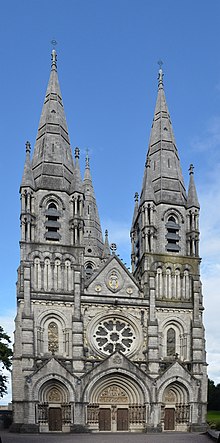| Saint Fin Barre's Cathedral, Cork | |
|---|---|
| Cathedral Church of Saint Fin Barre | |
Ardeaglais Naomh Fionnbarra | |
 West façade | |
| 51°53′40″N 8°28′50″W / 51.8944°N 08.4806°W | |
| Location | Bishop Street, Cork, T12 K710 |
| Country | Ireland |
| Denomination | Church of Ireland |
| Website | https://www.corkcathedral.com/ |
| History | |
| Dedication | Fin Barre of Cork |
| Architecture | |
| Architect(s) | William Burges |
| Style | Gothic Revival |
| Groundbreaking | 1865 |
| Completed | 1879 |
| Specifications | |
| Bells | 13 (1870, reinstalled 2008) |
| Administration | |
| Province | Dublin |
| Diocese | Cork, Cloyne and Ross |
| Clergy | |
| Bishop(s) | Paul Colton |
| Dean | Nigel Dunne |
| Precentor | The Dean of Cloyne |
| Chancellor | The Dean of Ross |
| Archdeacon | Adrian Wilkinson |
| Laity | |
| Director of music | Peter Stobart |
Saint Fin Barre's Cathedral (Irish: Ardeaglais Naomh Fionnbarra) is a Gothic Revival three-spire Church of Ireland cathedral in the city of Cork. It is located on the south bank of the River Lee and dedicated to Finbarr of Cork, patron saint of the city. Formerly the sole cathedral of the Diocese of Cork, it is now one of three co-cathedrals in the United Dioceses of Cork, Cloyne and Ross in the ecclesiastical province of Dublin. Christian use of the site dates back 7th-century AD when, according to local lore, Finbarr of Cork founded a monastery. The original building survived until the 12th century, when it either fell into disuse or was destroyed during the Norman invasion of Ireland. Around 1536, during the Protestant Reformation, the cathedral became part of the established church, later known as the Church of Ireland. The previous building was constructed in the 1730s, but was widely regarded as plain and featureless.
The cathedral's demolition and rebuild was commissioned in the mid-19th century by an Anglican church intent on strengthening its hand after the reforms of penal law. Work began in 1863, and resulted in the first major commissioned project for the Victorian architect William Burges, who designed most of the cathedral's architecture, sculpture, stained glass, mosaics and interior furniture. Saint Fin Barre's foundation stone was laid in 1865. The cathedral was consecrated in 1870 and the limestone spires completed by October 1879.
Saint Fin Barre's is mostly built from local stone sourced from Little Island and Fermoy. The exterior is capped by three spires: two on the west front and one above the nave, at the crossing with the transept. Many of the external sculptures, including the gargoyles, were modelled by Thomas Nicholls.[1] The entrances contain figures of over a dozen biblical characters, surmounted by a tympanum showing a Resurrection scene.
- ^ Eastlake 1872, p. 354.
